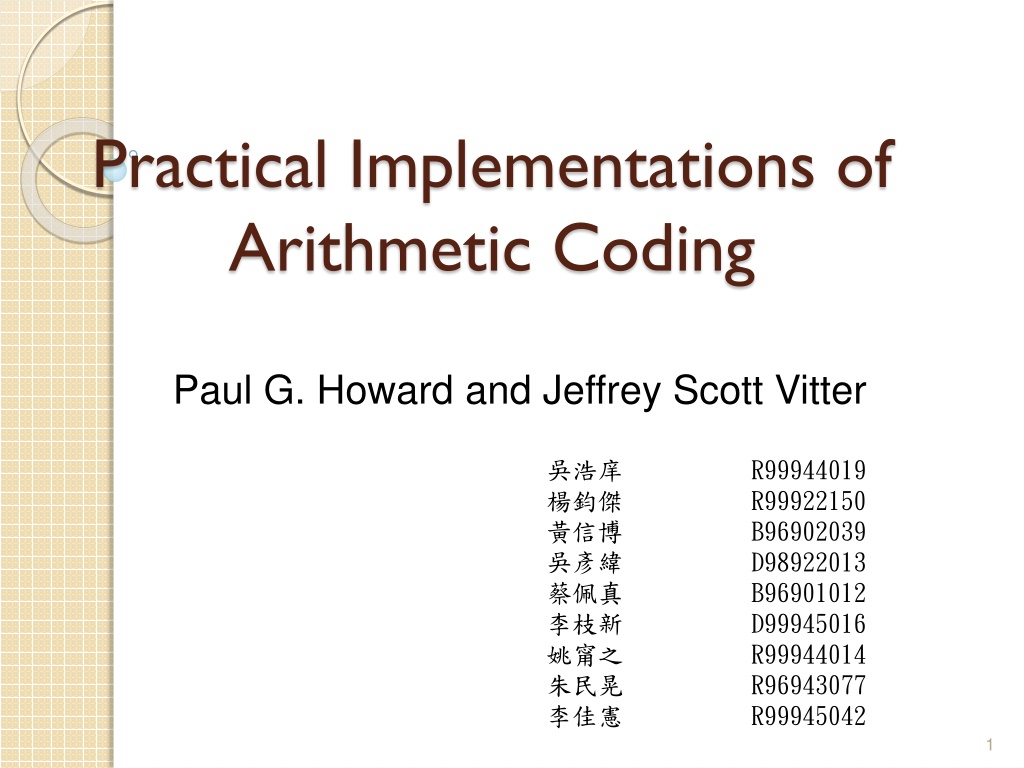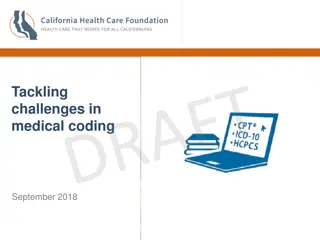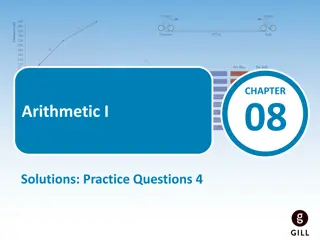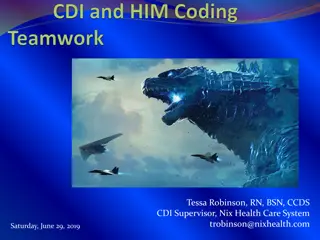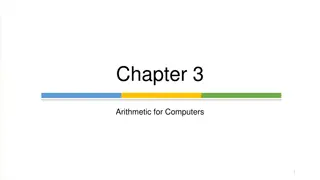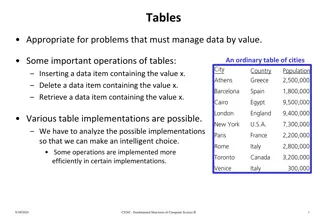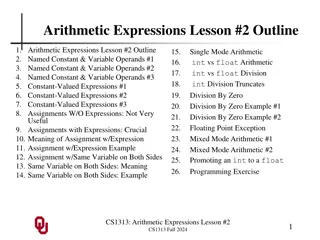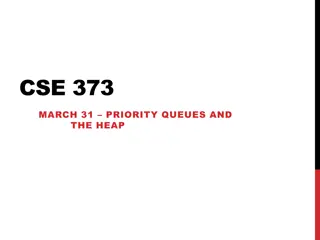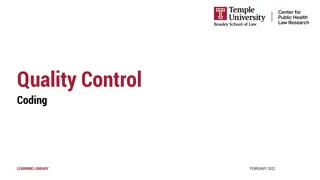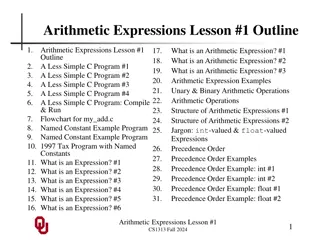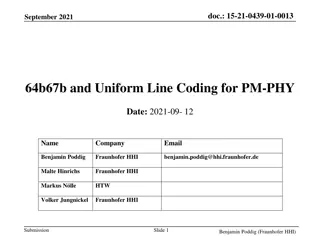Practical Implementations of Arithmetic Coding
Explore the practical implementations, advantages, and disadvantages of arithmetic coding in this informative guide. Learn about the basic algorithm, dynamic interval expansion, integer arithmetic coding, and methods to improve the speed of arithmetic coding. Dive deep into encoding algorithms, examples, and more to enhance your understanding of this encoding technique.
Download Presentation

Please find below an Image/Link to download the presentation.
The content on the website is provided AS IS for your information and personal use only. It may not be sold, licensed, or shared on other websites without obtaining consent from the author. Download presentation by click this link. If you encounter any issues during the download, it is possible that the publisher has removed the file from their server.
E N D
Presentation Transcript
Practical Implementations of Arithmetic Coding Paul G. Howard and Jeffrey Scott Vitter R99944019 R99922150 B96902039 D98922013 B96901012 D99945016 R99944014 R96943077 R99945042 1
Arithmetic Coding Advantage Flexibility Optimality Disadvantage Slowness 2
Overview Section 2 : Tutorial on Arithmetic coding Basic algorithm Dynamic Interval expansion Integer arithmetic coding Section 3 Improving the speed of Arithmetic coding 3
Basic Algorithm 1. Begin with at current interval [L,H) initialized to [0,1). 0 1 4
Basic Algorithm 2. For each symbol of the file, we perform : (a.) Subdivide current intervals into subintervals, one for each symbol. PC= ?=1 PN= ?=1 p? The new subintervals : [L+ PC(H L ), L + PN (H L ) ) ? 1p? ? (b.) Select the subinterval corresponding to the next symbol to be read. ( ex : ai) 5
Basic Algorithm 3. Output enough bits to distinguish the final current interval from all other possible final intervals. Length of final subinterval = product of the probabilities of the individual symbol = probability p of the symbols in the file. Final step use almost exactly log2 p bits 7
Encoding algorithm for arithmetic coding L = 0.0 ; H =1.0 ; while not EOF do range = H -L; read(ai) ; H = L + range H(ai) ; L = L + range L(ai) ; End while 8
Arithmetic Coding Example Symbol a b EOF Probability 0.4 0.5 0.1 Range [0.00,0.4) [0.40,0.90) [0.90,1.00) Suppose that we want to encode the following message: b b b EOF 9
Arithmetic Coding Example 0.812 5 0.7 0 0.6 0.0 0 0.4 a 0.7 0 0.4 0.6 b b b 0.8 5 0.82 5 0.90 0.812 5 EO F EO F 1.00 0.90 0.825 0.8 5 0.82 5 10
Arithmetic Coding Example Subintervals Current Interval [L,H) Action Input a b EOF Subdivide [0.000,0.400) [0.400,0.900) [0.900,1.000) b [0.000,1.000) Subdivide [0.400,0.600) [0.600,0.850) [0.850,0.900) b [0.400,0.900) Subdivide [0.600,0.700) [0.700,0.825) [0.825,0.850) b [0.600,0.850) Subdivide [0.700,0.750) [0.750,0.812) [0.812,0.825) EOF [0.700,0.825) [0.8125,0.825) 11
Arithmetic Coding Example Final Interval = [0.8125,0.825) = [0.11010 00000,0.11010 01100) (binary form) We can uniquely identify this interval by 1101000. Probability p = (0.5) x (0.5) x (0.5) x (0.1) = 0.0125 Code length = - lg p = 6.322 12
Dynamic Interval expansion The problem of basic arithmetic coding : the shrinking current interval requires the use of high precision arithmetic IEEE 754 standard : Single precision => 10^-7 Double pricision => 10^-16 Only less than 30 symbols can be coded! We need Dynamic Interval expansion 13
Dynamic Interval expansion Keep the current interval length a little larger than 1/2 14
Dynamic Interval expansion An example : 15
Whats Arithmetic Coding for? It s for compression. 0.8125/ 1101000 Magic number bbb bbb Decoder Encoder The file to be sent Received file 16
0110 0010 (6) (2) 17
Whats Arithmetic Coding for? Compression Compression is usually fulfilled by making good use of symbol probabilities. Unbalanced symbol probabilities imply better compression ratio. 0.8125/ 1101000 Magic number bbb bbb Decoder Encoder The file to be sent Received file 01100010 01100010 01100010 00011010 01100010 01100010 01100010 00011010 1101000 7bits 4 bytes = 32bits 4bytes = 32bits 18
Integer Arithmetic Coding In practice, arithmetic coding is slow. Too many floating-point operations Solution1: To buy powerful FP processors Solution2: Integer arithmetic coding Overview maintain integral intervals here 0.8125/ 1101000 Magic number bbb bbb The file to be sent Received file Decode r Encode r still a real number here 19
New interval calculation General Arithmetic Coding New interval calculation requires FP operations Integer Arithmetic Coding New interval calculation requires only INT operations 20
Current Interval- FP Current Interval- INT Subinterval a (Pa= 0.4) Subinterval n (Pb= 0.5) Subinterval EOF (PEOF= 0.1) In- put Action b [0.00, 1.00) [0000,9999) Subdivide [0.00, 0.40) [0000,4000) [0.40, 0.90) [4000,9000) [0.90, 1.00) [9000,9999) b [0.40, 0.90) [4000,9000) Subdivide [0.40, 0.60) [4000,6000) [0.60, 0.85) [6000,8500) [0.85, 0.90) [8500,9000) Output 1 [0.60, 0.85) [6000,8500) Expand [1/2,1) b [0.20, 0.70) [2000,7000) Subdivide [0.20, 0.40) [2000,4000) [0.40, 0.65) [4000,6500) [0.65, 0.70) [6500,7000) [0.40, 0.65) [4000,6500) Follow Expand [1/4,3/4) EOF [0.30, 0.80) [3000,8000) Subdivide [0.30, 0.50) [3000,5000) [0.50, 0.75) [5000,7500) [0.75, 0.80) [7500,8000) Output 10 [0.75, 0.80) [7500,8000) Expand [1/2,1) Output 1 [0.50, 0.60) [5000,6000) Expand [1/2,1) [3000+5000*4/10, 3000+5000*9/10) Output 0 [0.00, 0.20) [0000,2000) Expand [0,1/2) Output 0 [0.00, 0.40) [0000,4000) Expand [0,1/2) Output 0 [0.00, 0.80) [0000,8000) 21
Drawback of Integer Arithmetic If there is gain, there is also lost. Approximation leads to longer code length Optimal code length is obtained under accurate probability Current Interval-INT Subinterval a (Pa= 0.88) Subinterval b (Pb= 0.02) Subinterval EOF (PEOF= 0.1) Action Input [000,999) Subdivide [000,880) [880,900) [900,999) a [000,774.4) [000,774) [774.4,792) [774,792) [792,880) [000,880) Subdivide b 22
Event probabilities -Generalized symbol probabilities Step1: Apply other methods to recognize events Step2: Collect probabilities of events Step3: Use arithmetic coding Happy Birthday to You Happy Birthday to You Happy Birthday to You Happy Birthday to You 24
[Advanced] Adaptive Model Take advantage of locality bbbbaabbb bbbbaabbc b:0 a:10 c:11 aaaaaabbaa aaaaaabbac b:0 a:10 c:11 a:0 b:10 c:11 bbbbaabbb bbbbaabbc b:0 a:10 c:11 25
[Advanced] Scaling Maintain symbol counts is a problem It can be arbitrarily large By periodically reduce all symbol s counts by the same factor, we can keep the relative frequencies approximately the same as usual. Taiwan-1M-Yuan.jpg Taiwan-1M-Yuan.jpg File:50 3zz.jpg 26
[Advanced] High Order Models P(i) > P( ) P( |last word = ) is almost 100% 27
3-1 REDUCED-PRECISION ARITHMETIC CODING 28
Reduced-Precision Arithmetic Coding Arithmetic operations table lookups Reduce the number of possible states Reduce N in [0,N) N must be even; 4-multiple is preferred Still completely reversible Decoder makes the same assignment Only the average code length is reduced 29
Definitions and Assumptions Definitions Follow: follow-on case Process is described in Dynamic Interval expansion : Cutoff probability between 1/2 and 3/4 Excess code length is not very sensitive to - : no output Assumptions Prob{0} is uniformly distributed on (0,1) Input of 0 and 1 are equally likely 30
Simplest Non-Trivial Coder (N=4) 1/4 0 1-a a 3/4 1 1/2 Probability 2 4 1 State 0 3 Output 00 01 10 11 31
Eliminate the need of follow 0 1/4 1-a a 3/4 1 1/2 Probability 2 4 1 State 0 3 Output 00 01 10 11 1 0 0- 1- 32
More/Less Probable Symbol Idea More/Less Probable Symbol (MPS/LPS): 1/0 Consider Prob{MPS} in [1/2, 1) only Combine transitions and eliminate states Probability 1/4 0 1/2 a 3/4 1 MPS: 1 LPS: 0 Output 1 1 0 00 0 33
LPS input MPS input MPS input LPS input Stat e State Next state Output Next state Output Output Next state Output Next state p [0, 4) 0 [0, 4) 1 [0, 4) [0, 4) 00 [0, 4) - [1, 4) <p<1 00 [0, 4) - [1, 4) [1, 4) [1, 4) 01 [0, 4) 1 [0, 4) [0, 4) 01 [0, 4) 1 34
1 1 1 1 0 - 1 - 1 00 35
Maximally Unbalanced Subdivision LPS input MPS input State Output Next state Output Next state [0, 8) 000 [0, 8) - [1, 8) [1, 8) 001 [0, 8) - [2, 8) [2, 8) 010 [0, 8) - [3, 8) [3, 8) 011 [0, 8) 1 [0, 8) 36
1 1 1 1 0 - - - 1 000 37
Elias Code LPS input MPS input State Next state STOP STOP STOP STOP STOP Output Output Next state [0, 2)/2 [0, 4)/4 [1, 4)/4 [0, 8)/8 [1, 8)/8 0 1 - 1 - - [0, 4)/4 [1, 4)/4 [0, 8)/8 [1, 8)/8 [2, 8)/8 00 01 000 001 38
A SIX-STATE CODER N=8 39
N=8 , a six-state coder a Maximally unbalanced subdivision b b b b b Output:0 41
N=8 , a six-state coder LPS MPS Prob{MPS} =7/8 LPS : 111 MPS : [0,7) 42
N=8 , a six-state coder Prob{MPS} =7/8 LPS : 111 MPS : [0,7) 0 1 2 3 4 5 6 7 8 000 001 010 011 100 101 110 111 MPS : [0,7) LPS :11 1 7 0 1 2 3 4 5 6 43
N=8 , a six-state coder LPS MPS Prob{MPS} =4/7 LPS : 1 [0,6) MPS : 0 Prob{MPS} =5/7 LPS : 1f MPS : [0,5) Prob{MPS} =4/7 LPS : 110 MPS : [0,6) 44
N=8 , a six-state coder Prob{MPS} =7/8 MPS : [0,7) 0 1 2 3 4 5 6 7 000 001 010 011 100 101 110 LPS : 1 MPS : 0 0 1 2 3 4 5 6 Prob{MPS} =5/7 LPS : 1f MPS : [0,5) Prob{MPS} =6/7 LPS : 110 MPS : [0,6) Prob{MPS} =4/7 LPS : 1 [0,6) MPS : 0 45
N=8 , a six-state coder Prob{MPS} =7/8 MPS : [0,7) 0 1 2 3 4 5 6 7 000 001 010 011 100 101 110 LPS : 1f MPS : [0,5) 0 1 2 3 4 5 Prob{MPS} =6/7 LPS : 110 MPS : [0,6) Prob{MPS} =4/7 LPS : 1 [0,6) MPS : 0 Prob{MPS} =5/7 LPS : 1f MPS : [0,5) 46
N=8 , a six-state coder Prob{MPS} =7/8 MPS : [0,7) 0 1 2 3 4 5 6 7 000 001 010 011 100 101 110 LPS : 110 MPS : [0,6) 0 1 2 3 4 5 6 Prob{MPS} =5/7 LPS : 1f MPS : [0,5) Prob{MPS} =4/7 LPS : 1 [0,6) MPS : 0 Prob{MPS} =6/7 LPS : 110 MPS : [0,6) 47
A class of reduced-precision coders FLEXIBLE CODER DESIGN 48
N= any power of 2 All states are of the form [k,N) Denote state [k,N) by k 0 1 2 3 4 5 6 7 8 000 001 010 011 100 101 110 111 49
N= any power of 2 Number of states is N/2 K N/2 will produce output, and interval will be expanded 0 1 2 3 4 5 6 7 8 000 001 010 011 100 101 110 111 50
